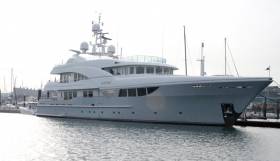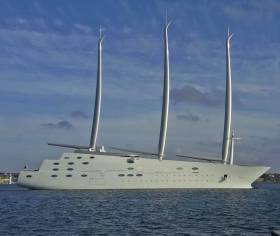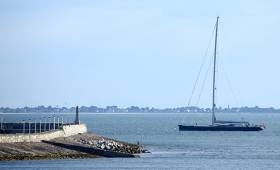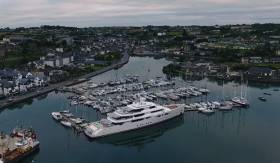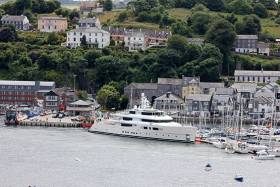Displaying items by tag: Superyacht
Megayacht, superyacht – certainly bigger than any craft in Bangor Marina. Lying alongside the Eisenhower Pier in Bangor Harbour on the North Down coast on a recent visit, after a passage from the Clyde, the 39.62 m motor yacht, Liquid Rehab arrived in Bangor for a brief stopover but stayed longer.
Built in 2004 by Westport Yachts, USA, whose sales office is in Fort Lauderdale in Florida and has two yards in Washington State, this huge three-decked craft cruises at 24 knots and has a top speed of 28 knots. She sleeps 10 and has a crew of seven.
Liquid Rehab is owned by Kevin Martyn, who is in the pharmaceuticals business and has an interest in the USA National Football League. Captain is Jameson Cooper, from North Palm Beach in Florida.
 Vice Commodore Alan Espey, (third right) welcomes Liquid Rehab owner Kevin Martyn (second right) and Captain Jameson Cooper (right) and friends to RUYC
Vice Commodore Alan Espey, (third right) welcomes Liquid Rehab owner Kevin Martyn (second right) and Captain Jameson Cooper (right) and friends to RUYC
Kevin Martyn, Jameson Cooper, members and friends were welcomed to Royal Ulster Yacht Club by Vice Commodore Alan Espey, where they enjoyed lunch in the famous Lipton Room.
Harbour Master Kevin Baird was delighted to welcome Liquid Rehab to Bangor and said on its arrival, " We wish all onboard an enjoyable visit and we trust you will enjoy your stay in Bangor".
Liquid Rehab is currently in Leith near Edinburgh and plans to return to the North Coast of Northern Ireland before calling in Belfast.
Kinsale Design Team Creating 206ft Sailing Superyacht
The largest boat currently racing in the Sovereigns Cup series at Kinsale is Conor Doyle's locally-based Xp50 Freya. For most of us, she's a biggy, and an elegant one at that. But if you were to exit Kinsale Yacht Club through its venerable original front door and amble town-wards along O'Connell Street, you'd soon reach the office of Rob Doyle Design, and find yourself grappling with decidedly abstruse concepts of big boat size several multiples of Freya.
For if you could inveigle your way therein, you'd find that one of the ideas they're working on is Project Fury, a concept 63-metre sloop-rigged superyacht which they're developing in tandem with Van Geest Design, with whom they're already working on two 52 metre sailboats under construction in The Netherlands.
 He's used to dealing with big numbers – Rob Doyle in his Kinsale design office.
He's used to dealing with big numbers – Rob Doyle in his Kinsale design office.
It boggles the mind as to why they've selected a name like Project Fury, but to get a notion of the proposed boat's size, there's some basis in the fact that 63 metres is 206ft, and therefore simple souls will latch onto the fact that she's more than four times longer than Freya. But that's only a distraction. Boat size increases volumetrically, and the figures zoom up exponentially.
 It all looks clean and simple, but there's an enormous design challenge in having all sail controls effective yet invisible, while incorporating features whereby the stern area opens up to become an on-board lido.
It all looks clean and simple, but there's an enormous design challenge in having all sail controls effective yet invisible, while incorporating features whereby the stern area opens up to become an on-board lido.
Thus as Project Furey's beam is envisaged as being 43ft, while her substantial and several-decked hull depth is augmented by a large multi-storey coachroof, it could be argued that she's all of twenty-fives times larger than Freya, and it wouldn't surprise us at all to hear that the factor is much greater then that.
Either way, it's an awful lot of boat. Yet the two design teams are determined to optimise her performance, so there's a certain creative dynamic tension between the Kinsale team's tradition of elegance and comfort, and the Dutch group's fondness for lightweight yet hyper-strong austerity. Either way, some very advanced construction techniques and special materials are involved at every level.
For the rest of us, it all looks entirely off the wall. But in this even-more-crazy-than-usual world of ours, Superyachts are currently one of the happening areas of economic activity and realisation.
But whether we'll ever see her in Kinsale is another matter. Even if the draft can be adjusted to suit the available depths, the masthead will be scraping expensively against the cloud-base……
 Imagine being on the helm of a machine like this – even the Masters of the Universe will have to form an orderly queue…..
Imagine being on the helm of a machine like this – even the Masters of the Universe will have to form an orderly queue…..
A new 100-metre sailing superyacht can - and must - be environmentally friendly and have as little impact on the ecosystem as possible say the promoters of the NL 285 "Vento" project, presented by designers Nuvolari Lenard at this week's Venice Boat Show 2021 that runs until the 6 June.
This, they claim, can be achieved by adopting 'virtuous behaviour' and combining the knowledge, technologies and materials we already know about. Carlo Nuvolari and Dan Lenard, founders of the Nuvolari Lenard Venetian design studio, are convinced of this. They have always been concerned with protecting the environment and have promoted responsible yacht design (their latest projects include Thunder, the 14-seater hybrid Venetian water taxi launched in 2020).
 Carlo Nuvolari and Dan Lenard, founders of the Nuvolari Lenard Venetian design studio
Carlo Nuvolari and Dan Lenard, founders of the Nuvolari Lenard Venetian design studio
BACK TO BASICS
Building on decades of experience in yacht design in all shapes and sizes, with hugely successful projects for iconic shipyards such as Oceanco, Palmer Johnson, Perini Navi and CRN Ferretti, Nuvolari Lenard decided to break the mould with a radical concept that integrates all the parameters of pure sailing with the needs of today's superyacht owner.
"Vento" will not be the umpteenth "sail assisted megayacht", but an authentic and extremely elegant 100-metre sailing vessel that will use wind as its natural propulsive force.
"Being environmentally conscious has to become a way of being, as well as a way of thinking," explains engineer Carlo Nuvolari. "There's nothing stopping us from thinking about a truly green large yacht. It's not difficult to achieve major results, you just have to stop being a traditionalist and take a risk, going back to the basics: building a sailing yacht that really uses sails and is really efficient.”
Watch Superyacht Crash into Dock in Sint Maarten (VIDEO)
A £65m superyacht crashed into a luxury Caribbean yacht club’s pier, causing ‘very significant’ damage, after reportedly suffering a computer malfunction.
The 235ft-long vessel is said to be owned by Capri Sun juice tycoon Hans Peter Wild, but it is not yet clear whether he was on board at the time according to the Daily Mail.
Video courtesy of Boomerang Boat Charter
In one video, an onlooker can be heard saying “oh my God” over and over again. In another clip, a witness said: “It’s hitting concrete now. What’s going on?”
The yacht’s captain was trying to leave the Simpson Bay Lagoon from its berth at Ile de Sol Marina when the crash happened.
Sint Maarten Yacht Club’s dock has been closed until further notice while the extent of the damage is assessed.
A statement from the yacht club says: “As most of you will have heard by now, this morning an accident occurred with a mega yacht. They lost control over the vessel and hit the dock of the Sint Maarten Yacht Club.
“Nobody was injured and the damage is solely structural, however, it is very significant. We are currently assessing the extent of the damage to make a plan to rebuild.”
Phocea Superyacht Yacht Fire: Crew Rescued from Vessel
The 75.13-metre sailing yacht known as Enigma and Phocea caught fire yesterday off an island near Langkawi, Malaysia as Superyacht Times reports.
While at anchor less than one nautical mile northeast of Pulau Singa Kecil (Lion Island), the 530 GT yacht was tended to by the Malaysian Maritime Enforcement Agency (MMEA), who rescued seven crewmembers who are reported to be safe and uninjured.
Once the fire was detected by a local patrol vessel, rescuers from the Malaysian Maritime 6 FLASH boat began fighting the flames and have been continuing to do so despite strong wind conditions. Kedah and Perlis MMEA director, Maritime First Admiral Mohd Zawawi Abdullah, said in a statement that the weather was "making the operation difficult."
 Phocea caught fire yesterday off an island near Langkawi, Malaysia
Phocea caught fire yesterday off an island near Langkawi, Malaysia
Enigma was built as a single-handed race yacht in 1976 to the design of Tim Heywood and interior designer Beiderbeck s. After crossing the Atlantic in 1976, she was converted to a cruise ship by her original builders, the French shipyard DCAN. In 1999/2000 her owner, a well-known individual after whom the 104.85-metre Lady Moura was named, ordered a major interior and exterior refit at the Lürssen shipyard in Germany. The yacht was again sold in 2010 to her current owners. Enigma accommodates 12 guests in a master suite, one VIP, two double and two twin cabins, and sleeps up to 23 crew members.
More from Superyacht Times here
#Superyachts - All indications show the superyacht market is turning around — and as it expands, it’s important to note that more and more of these vessels are eschewing crowded Mediterranean spots and cruising instead in Northern European waters.
Typically these luxury craft, many greater than 50 metres in length, are heading to northern destinations such as the Orkney Islands, Norway and Sweden that are already popular with cruise liners.
On the way, they’re transiting the Irish Sea — and seeking opportunities for safe and convenient berths close to transport links in the UK and Ireland alike. Dun Laoghaire is perfectly positioned to capitalise on this market.
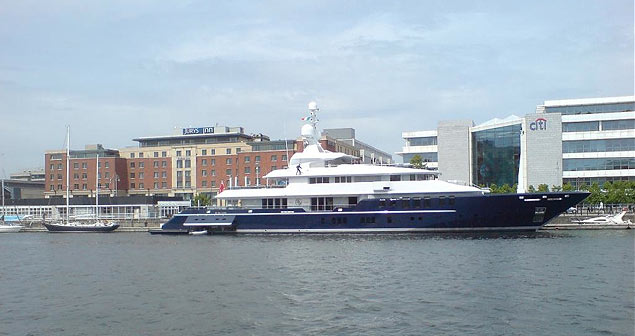 The completion of the Samuel Beckett Bridge across the River Liffey in Dublin City effectively meant the demise of the Dublin City Mooring facility in 2010 as large craft could no longer transit the river. During their relatively short period of operation, the modest Dublin City Mooring pontoons in the heart of Dublin was able to attract a number of superyachts (like the Triple 7 above) to berth on their pontoon which was located conveniently in the heart of Dublin. This is no longer possible and has effectively ended Dublin as a destination for visiting superyachts but these superyachts still want to come here
The completion of the Samuel Beckett Bridge across the River Liffey in Dublin City effectively meant the demise of the Dublin City Mooring facility in 2010 as large craft could no longer transit the river. During their relatively short period of operation, the modest Dublin City Mooring pontoons in the heart of Dublin was able to attract a number of superyachts (like the Triple 7 above) to berth on their pontoon which was located conveniently in the heart of Dublin. This is no longer possible and has effectively ended Dublin as a destination for visiting superyachts but these superyachts still want to come here
Above and beyond the local spend on overnight berths, and victualling these superyachts, there are significant opportunities to target high net worth individuals in the luxury tourism market. And Dublin is a recognised go-to destination.
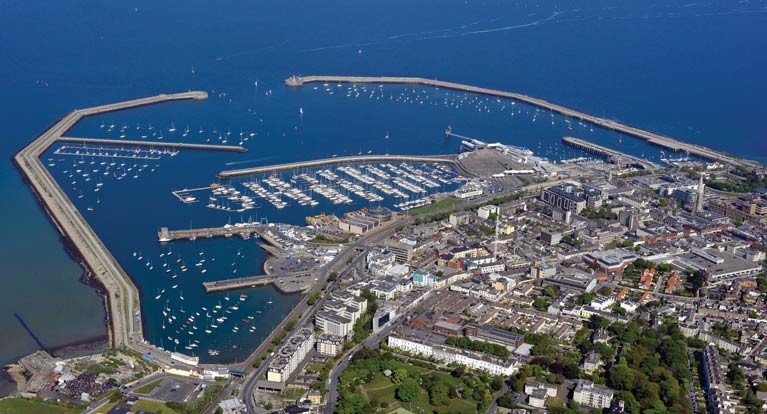 The Dun Laoghaire Harbour Company is currently marketing the harbour as a cruise ship destination in competition to the existing location of Dublin Port. It is seeking to establish the harbour as a stop over for small to medium sized cruise ships and has identified the Carlisle Pier for this purpose. Super yachts can also be accomodated in this plan. Photo: Michael Chester
The Dun Laoghaire Harbour Company is currently marketing the harbour as a cruise ship destination in competition to the existing location of Dublin Port. It is seeking to establish the harbour as a stop over for small to medium sized cruise ships and has identified the Carlisle Pier for this purpose. Super yachts can also be accomodated in this plan. Photo: Michael Chester
Many of these superyachts are the size of small ships, weighing over 250 tonnes. It means they’re too big for Dun Laoghaire’s 800–berth yachting marina, but they represent a welcome boon for a harbour vacant since the loss of the Stena HSS ferry service. One recent arrival into Dun Laoghaire was the magnificent Atlantic schooner from America in August. Read Aflaot.ie's article on the Atlantic's visit here.
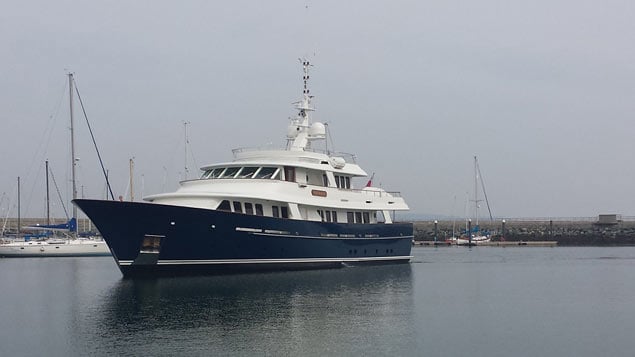 The 35.80m Arcadia berthed in Dun Laoghaire in September 2014. Not only does the impressive 'Arcadia' have gorgeous lines but as the 159th vessel to transit the Northwest Passage, she's also a serious long distance expedition motor yacht too
The 35.80m Arcadia berthed in Dun Laoghaire in September 2014. Not only does the impressive 'Arcadia' have gorgeous lines but as the 159th vessel to transit the Northwest Passage, she's also a serious long distance expedition motor yacht too
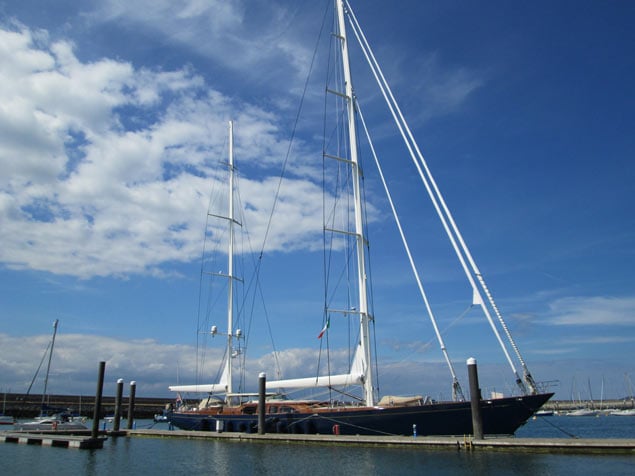 Even seasoned observers were gobsmacked at the sheer size of the 46–metre (150–foot) Superyacht Christopher berthed at Dun Laoghaire marina in 2014, dwarfing all 500 local craft in the harbour. Christopher represents the upper limit of craft permitted at the marina due to weight and draft restrictions. In fact Christoper could only be facilitated in the marina due to the fact she has a lifting keel
Even seasoned observers were gobsmacked at the sheer size of the 46–metre (150–foot) Superyacht Christopher berthed at Dun Laoghaire marina in 2014, dwarfing all 500 local craft in the harbour. Christopher represents the upper limit of craft permitted at the marina due to weight and draft restrictions. In fact Christoper could only be facilitated in the marina due to the fact she has a lifting keel
What's more thanks to the Failte Ireland accredited marina, it has the type of 'concierge' facilities to deal with visiting superyachts: everything from car hire to hotel bookings.
But this isn't an overture for billionaires who have no place to park their superyacht. There's a business case to say that Dun Laoghaire town can easily take advantage of this.
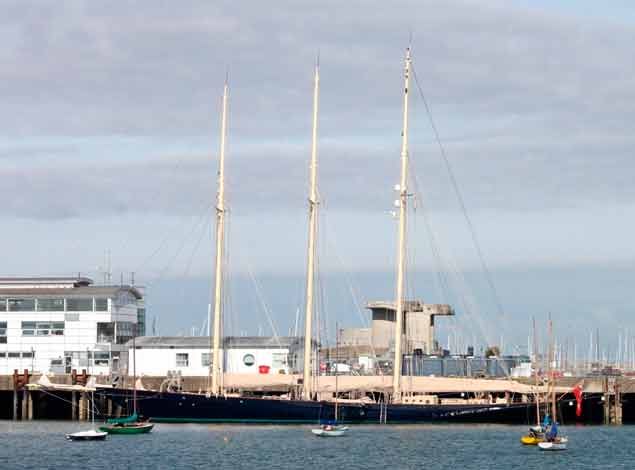 The two-year-old 185–ft three-masted schooner Atlantic alongside at Dun laoghaire Harbour in August. The replica that was too big for the yachting marina stayed for a week at a secure but somewhat neglected (below) berth No.4 alongside at the abandoned ferry terminal. Photos: Twitter
The two-year-old 185–ft three-masted schooner Atlantic alongside at Dun laoghaire Harbour in August. The replica that was too big for the yachting marina stayed for a week at a secure but somewhat neglected (below) berth No.4 alongside at the abandoned ferry terminal. Photos: Twitter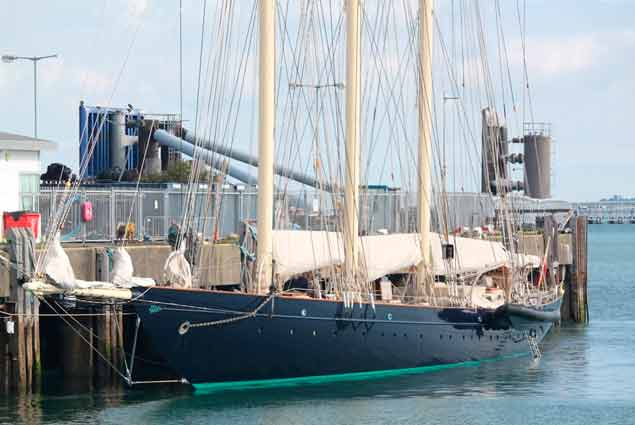 The facilities required to operate a Super yacht berth amenity are relatively few. A serviced, heavy duty linear concrete pontoon of approximately 80–100m length with shore access via a bridge. Secure access by crew, guests and staff only. Crew facilities could be located in the ferry terminal and be accessible 24 hours to include toilet and shower facilities and wifi access. There is an existing level of security infrastructure which would be utilised including CCTV and Harbour Police to give added assurance to crew and guests that their boat will be secure at all times
The facilities required to operate a Super yacht berth amenity are relatively few. A serviced, heavy duty linear concrete pontoon of approximately 80–100m length with shore access via a bridge. Secure access by crew, guests and staff only. Crew facilities could be located in the ferry terminal and be accessible 24 hours to include toilet and shower facilities and wifi access. There is an existing level of security infrastructure which would be utilised including CCTV and Harbour Police to give added assurance to crew and guests that their boat will be secure at all times
At a time when nothing seems to be going right for Dun Laoghaire, these boats could be an important part in the mix of rejuvenating the harbour, bringing much needed revenues — and a splash of glamour.
They’re coming here already, but more could be done to market Dun Laoghaire as a superyacht destination that could even see the harbour as a winter lay-up hub, too.
To attract them would not need consultants, planning permission, investment, tenders — just the space they need. And that’s already available in Dun Laoghaire, which has four vacant ship berths capable of accommodating such vessels.
The question isn’t whether Dun Laoghaire can attract this lucrative superyacht business — the question is, who in the harbour will take the initiative?
 Source: Towergate Insurance
Source: Towergate Insurance
'World’s Largest Sailing Superyacht' Takes To The Water
#Superyacht - Sailing tests have begun on what’s purported to be one of the world’s largest sailing yachts, as Mail Online reports.
Sailing Yacht A’s functional name is very much an understatement, as this enormous vessel is more than 140m long, comprising eight decks with 90m masts, making it more like a skyscraper than the boats moored at your local marina.
Priced at some €365 million, and designed by the renowned Philippe Starck, the luxury ship was built in Germany for Russian billionaire Andrey Melnichenko as a replacement for his 2008 vessel Motor Yacht A, another Starck design.
The new A also boasts the latest in sailing technology, with digitally controlled sails, a carbon-fibre-impregnated hull and bomb-proof glass.
It’s not the only superyacht in the news, as Royal Huisman has taken an order for its largest vessel to date — and the largest aluminium hulled yacht yet conceived — at a comparatively modest 81m in length. Yacht Harbour has more on the story HERE.
This story has been updated with additional information.
Maltese Flagged Superyacht Arrives in Dun Laoghaire Harbour
Dun Laoghaire harbour welcomed the Maltese flagged cruising superyacht 'Ganesha' this morning. The 46 metre sailing yacht arrived into the Irish east coast port and took a prime marina berth, she's the second superyacht appearance in a month for Dun Laoghaire, record breaking Rambler 88 arrived in port prior to last month's Round Ireland race.
The 46m Vitters build is named after an Indian deity and is a regular on the international superyacht regatta circuit.
Superyachts are becoming regular visitors to the Irish coastline as facilities such as coastal marinas improve. Kinsale welcomed The 55m ‘Galileo G’ in May and this month the south coast port received the 73m Grace E arrived at the yacht club marina.
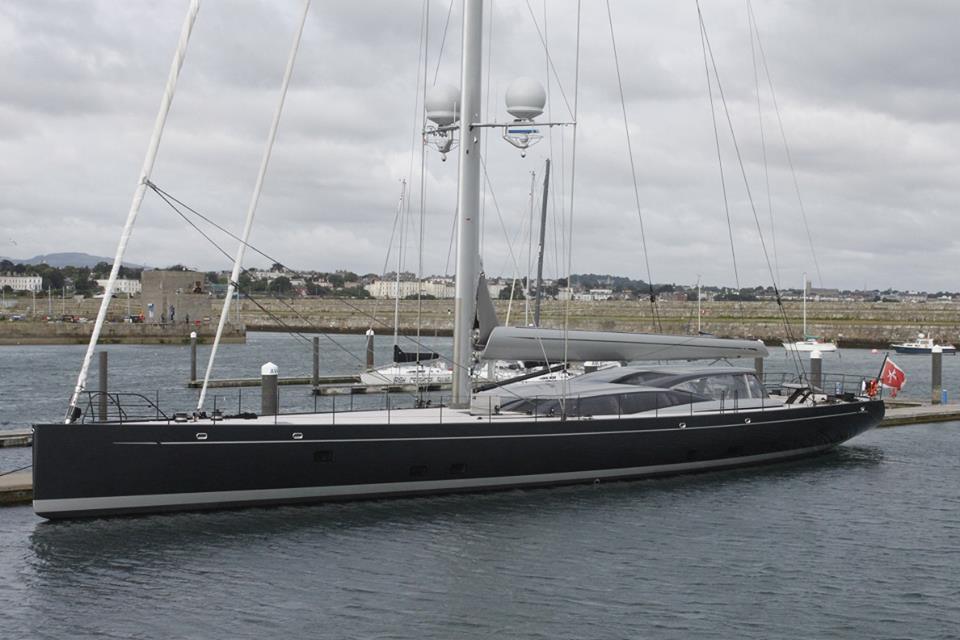 150–ft superyacht Ganesha along side at Dun Laoghaire marina this morning. Photo: Dun Laoghaire marina
150–ft superyacht Ganesha along side at Dun Laoghaire marina this morning. Photo: Dun Laoghaire marina
Kinsale Marina & Super Yacht Video From The Air
With aerial views of the Charles Fort, James Fort, visiting Super yacht 'Grace E' and the town marina, Kinsale is filmed by drone pilot Daniel Foran with spectacula results for the harbour that marks the start of the Wild Atlantic Way.
Superyacht 'Grace E' Calls to Kinsale
The latest superyacht visitor to Kinsale Yacht Club Marina makes quite an impact alongside at the yacht club pontoon today.
'It's not too often we get these large boats into visit' Matthias Hellstern, Kinsale Yacht Club's Rear Commodore told Afloat.ie
‘Grace E’ is a Superyacht, 73 metres in length and built in 2014 by Perini Navi Group Italy. She won Motor Yacht of the Year at the World Superyacht Awards 2015
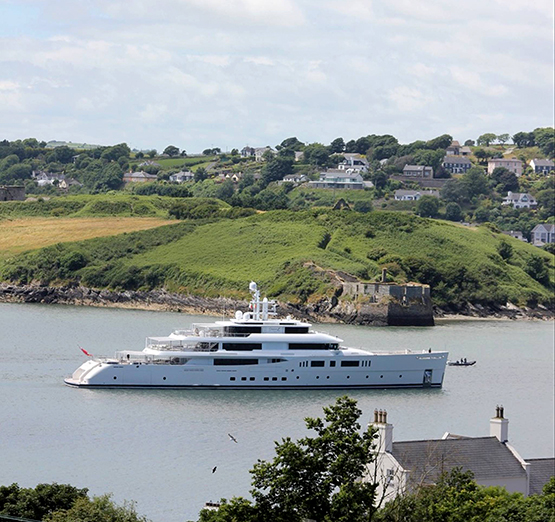 Superyacht 'Grace E' moored in Kinsale harbour
Superyacht 'Grace E' moored in Kinsale harbour



























